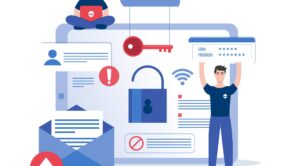Shocking Cybercrime Statistics and How You Can Protect Yourself
As the number of new cyber vulnerabilities continue to increase exponentially on a global scale, companies should start taking this kind of threat more seriously. Businesses that rely heavily on the internet for transactions and when interacting with their clients are the most vulnerable to cybercrime as they are constantly on the crosshairs of hackers.
Even businesses do not conduct transactions online are still prone to various cybercrimes and threats such as data theft, denial of service attacks and ransomware. If you own a business and part of its day-to-day operations take place online, then the following cybercrime statistics should be enough to make you re-evaluate your online security.

Cybercrime Statistics From 2016 to 2018

Hacker Attacks Occur Once Every 39 Seconds
A study conducted at the University of Maryland suggests that one hacker attack on any device that is connected to the internet happens every 39 seconds. Hackers use various means to breach security measures including exploiting operating system vulnerabilities, deciphering username and password combinations, phishing and fake websites.
Hackers Also Target Small-to Medium-scale Businesses
You might think that your business is too small to be noticed by hackers, but your company’s size does not matter. Among the attacks on businesses include web-based attacks, phishing, malicious codes, botnets and distributed denial-of-service (DDoS).
Cybercrime Is on the Rise in the U.K.
Cybercrime has been running rampant in the United Kingdom. According to the U.K.’s National Crime Agency, more than 50 percent of crimes reported in 2016 were cybercrimes.
Projected Cyber Attacks in 2019 and the Future

Attacks on Artificial Intelligence
As artificial intelligence (AI) systems become the norm in various areas of business operations, it becomes a promising target for hackers who will try to look for vulnerabilities that they can exploit. AI systems are very helpful in automating repetitive manual tasks, aid in timely and efficient decision making and perform what otherwise would be tedious undertaking for humans. Since AI systems are generally autonomous, hackers may seek to corrupt its code with malicious logic that can adversely affect its operations.
Increased Attack on IoT Devices
Networked devices can become yet another target for hackers. Internet of Things (IoT) devices, or devices with their own internet protocol addresses, can theoretically become pathways that hackers can use to break into networks. Alarm systems, closed-circuit televisions, printers, copiers, thermostats and vending machines are just some business IoT devices that hackers can exploit.
Evolved Hacking Techniques to Steal Data in Transit
Office networks and even home-based Wi-Fi routers can become new targets for hackers. Apart from server- and device-based malware, hackers may look for other ways to steal banking details or credit card numbers by gaining access via network hubs and routers. This type of hacking may be a game changer as it will make hackers capable of intercepting sensitive data while in transit.
What You Can Do to Protect Your Business

Using professional internet and network tools like firewalls, antimalware, antispyware and antivirus software would be a step in the right direction in making your business safer and more secure. However, such tools may not be enough to keep hackers at bay. While you may have a capable information technology (IT) team in your employ, they may not have enough experience when it comes to dealing with hackers.
The ideal way to protect your business from cybercrime is to hire experts in cybersecurity. Experts in the field can search and identify any vulnerability in your system, and then work with your IT team to reinforce your entire network architecture to make it more secure. While such services may come at an additional cost, going this extra mile might be all that you will need to protect your business from cybercrime.
















